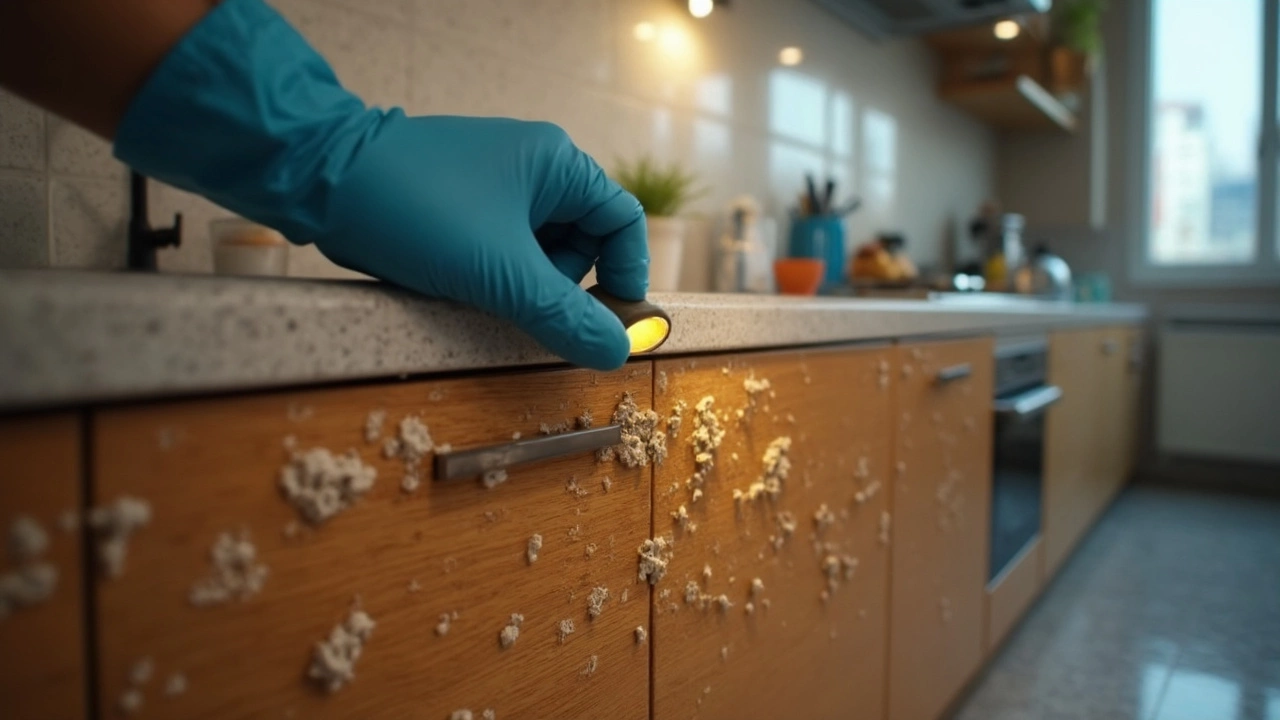Most people think mold is only a problem in old, damp houses. But get this—a brand-new build can have just as much mold hiding out. Some new houses are even more likely to have mold issues because construction crews rush to close them up or don't dry out materials fully. The paint might be fresh, but if water got trapped under the floors or behind the walls, mold can start growing in days, not years.
Lately, I've seen friends move into beautiful new homes and start sneezing non-stop or getting headaches they never had before. Mold spores are tricky—they don't stay put; they ride the air like tiny hitchhikers and can irritate your nose, throat, and even your lungs. And it's not just people—my dog Bailey started scratching her ears way more when we stayed at a friend's new apartment, which we later found out had a hidden leak in the ceiling.
If you're about to move into a new build, or you've just moved in and noticed some weird smells or allergy-like symptoms, don't brush it off. Mold can sneak in fast, and it's not as harmless as it looks. Next, let’s look at why mold is showing up in new homes and what you can do about it.
- Why Mold Pops Up in Brand-New Buildings
- Health Issues Linked to Indoor Mold
- How to Spot Mold (Even if You Can't See It)
- How to Prevent and Fix Mold Problems in New Homes
Why Mold Pops Up in Brand-New Buildings
It’s wild how often mold shows up in new builds. You’d think all that shiny new construction would keep stuff like this away, but nope. Modern construction can actually make mold problems more likely. Here’s why.
First, builders move fast. They put up walls and lay down flooring before lumber and drywall are totally dry, especially if it rained during construction. Once everything’s sealed up, any leftover moisture gets trapped inside. That’s basically an open invitation for mold to move in.
Another thing: energy-efficient homes are built tight to save on heating and cooling. Sounds great for your bills, but all that airtightness means moisture (from showers, cooking, or even just people breathing) has nowhere to go. Mold loves still, damp air.
Building codes focus a lot on safety, but not always enough on mold prevention. Some developers skip proper ventilation or forget to install vapor barriers in the rush to finish. These shortcuts leave hidden places—like attics, wall cavities, or basements—where mold can thrive.
During 2024, inspectors found that about 28% of water damage insurance claims in brand-new homes came from leaks in windows, roofs, or plumbing. The numbers add up fast and show how common the risk is, not just in old houses. Check out this simple table for where mold most often pops up in new builds:
| Problem Area | Common Cause | Risk Level |
|---|---|---|
| Bathrooms | Poor ventilation, leaky pipes | High |
| Basements | Improper waterproofing | Medium |
| Attics | Blocked vents, wet insulation | Medium |
| Behind Walls | Trapped construction moisture | High |
| Windows | Bad sealing or flashing | High |
One last thing to keep in mind: Even appliances like dryers or air conditioners need to be installed right. If drains or vents are blocked, they’ll quietly make the perfect home for mold—without anyone noticing for months. Keeping a close eye after moving in can save you a lot of headaches (and trips to the hardware store).
Health Issues Linked to Indoor Mold
If you’re suddenly sneezing, coughing, or feeling tired after spending time indoors, especially in a new build, mold could be the hidden culprit. Mold spores float around in the air, so you don’t even need to see visible mold to start having issues. Your nose and lungs are the first to get hit, but mold can mess with your whole body.
The symptoms can vary a lot. Some people just notice itchy eyes or a stuffy nose. Others wake up every day with headaches, tiredness, or even asthma attacks. Kids and the elderly are more likely to have bigger problems. If someone in the house already has asthma, allergies, or a weak immune system, mold can hit them even harder.
- Allergic reactions: Sneezing, runny nose, itchy eyes, and even skin rashes are common.
- Asthma flare-ups: Mold can set off wheezing, coughing, and trouble breathing in people with asthma.
- Respiratory issues: Even people without allergies can get sore throats, stuffy sinuses, or regular coughing.
- Fatigue and headaches: Sometimes the only sign is feeling drained or getting frequent headaches.
Some molds, like the infamous black mold (Stachybotrys), make toxins called mycotoxins. These are a bigger deal and have been reported to cause serious symptoms in sensitive people or if the mold is widespread. But even regular molds can make you feel lousy if you breathe in a lot of spores every day.
Check out this quick snapshot of what mold can do to your health, based on different people:
| Group | Common Symptoms | Chance of Serious Issues |
|---|---|---|
| Healthy adults | Itchy eyes, coughing, sneezing | Low to medium |
| Kids | Wheezing, asthma attacks, skin rashes | Medium to high |
| Seniors | Sinus infections, chest tightness | Medium to high |
| People with asthma/allergies | Severe allergy symptoms, breathing trouble | High |
If you or anyone in your house has these symptoms that get better when you leave home, that’s a red flag. Don’t just buy more tissues—look for the source. Mold could be lurking under floors, behind drywall, or around leaky windows. Next up, let's get into how you can actually spot mold—even when it's hiding out of sight.

How to Spot Mold (Even if You Can't See It)
You'd think mold would at least be obvious—big green or black fuzz on the walls, right? Not always. Mold loves to hide where you can't easily find it: behind drywall, under carpets, inside HVAC vents, or around leaky pipes sealed up out of sight. Just because you don’t see fuzzy patches doesn’t mean your house is in the clear.
Your nose is often your first clue. A musty, earthy smell—sort of like wet socks—lingering even after cleaning can signal mold, especially if the scent gets stronger near bathrooms, laundry rooms, or basements. Sometimes you’ll notice black or green spots on window sills, corners, or grout, but just as often the problem is invisible.
Pay attention to how you feel at home versus outside. If your allergies, headaches, or coughing ramp up inside but chill out when you leave, that’s a red flag. Pets can react too. My dog Bailey started sneezing and itching every time we visited a friend’s place that turned out to have hidden water damage in the ceiling.
- Look around sinks, tubs, and windows for dark spots or warped trim.
- Check for bubbling paint or areas where walls or ceilings seem soft or saggy.
- Notice if floors feel damp or cold in places they shouldn’t.
- If you spot condensation on windows or pipes that doesn't go away, mold might be brewing nearby.
If you want to take it further, you can buy a mold test kit at a hardware store for about twenty bucks. These aren’t perfect, but they can tell you if mold spores are floating around. For peace of mind, talk to a professional who knows how to test behind walls with moisture meters or infrared cameras.
The quicker you catch mold, the less damage—and health trouble—you’ll face down the line. So trust your nose, your body's signals, and never ignore the signs, even if the place looks spotless on the surface.
How to Prevent and Fix Mold Problems in New Homes
Honestly, no one moves into a brand new place thinking mold is going to be an issue. But with today’s airtight construction and busy building schedules, moisture gets trapped more easily, and that’s like rolling out a welcome mat for mold. You need a game plan for prevention—and a backup plan in case mold sneaks in anyway.
First, you want to control moisture from day one. Mold can’t grow without water, so the less dampness you have inside, the better. Here are the main things you can do:
- Make sure your home builder did a final moisture check on walls, floors, and crawl spaces (this should be in your handover paperwork—don’t be afraid to ask for it).
- Run exhaust fans in your bathrooms and kitchen every time you cook or shower, even if the house still smells new.
- Keep your HVAC system in good shape—replace filters every couple of months and have a pro check it yearly so it can actually control humidity.
- If you see condensation on windows or walls after a shower or rainy day, that’s a red flag. Wipe it away and track down the source right away.
- Use a dehumidifier if you notice your humidity stays near or above 60%—grab a cheap humidity monitor to check. A level above 50% is mold’s sweet spot.
Sometimes, even if you do everything right, a hidden plumbing leak or a botched roof job lets water in. If you find a musty smell or see spots on walls or baseboards, don’t ignore it. Here’s how you can tackle it yourself—or know when to call in a pro:
- Suit up with gloves and an N95 mask before cleaning any mold you can see. This isn’t overkill—it’s basic safety.
- For small spots on hard surfaces, scrub with soap and water. Don’t use bleach on drywall—it just lightens the mold but doesn’t kill it.
- Anything bigger than a bath towel or showing up on porous stuff (like drywall or carpet)? That’s not a DIY job. Call a certified mold remediator. Your builder’s warranty might even cover it if your place is less than a year old.
- Fix the root of the problem (like patching leaks or sealing windows) or it’ll just come back. Mold doesn’t care if you paint over it.
Just for some perspective, check out how humidity and moisture issues can sneak up in new builds, based on recent studies:
| Problem | % of New Builds Affected* |
|---|---|
| Construction moisture left in walls | 30% |
| Poor attic ventilation | 25% |
| Bathroom exhaust not vented outdoors | 15% |
| Unsealed foundation cracks | 10% |
*Data from the 2023 Home Builder Practices Survey, U.S. Midwest region
One last thing—don’t assume that a brand new place is immune to mold problems, especially with weather getting wilder every year. Stay alert, ask questions during the handover, and don’t let a ‘new home smell’ cover up a damp issue.
